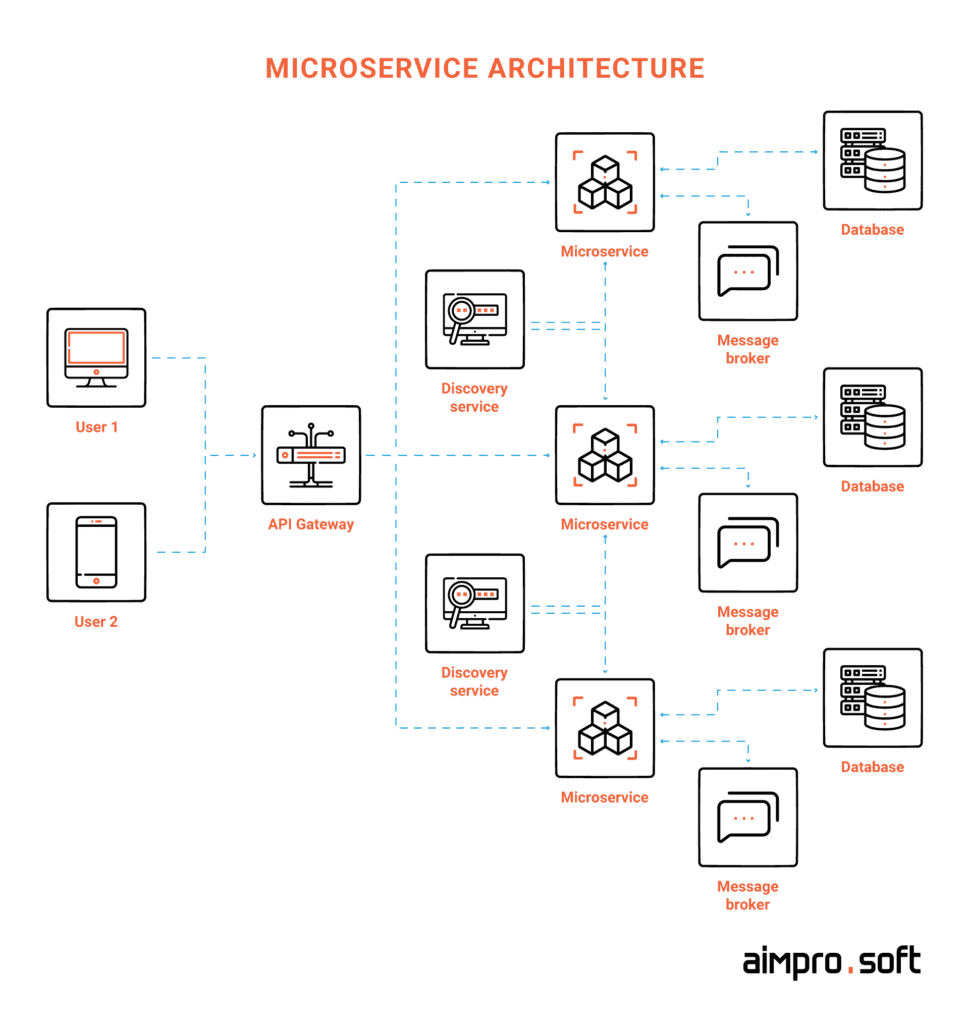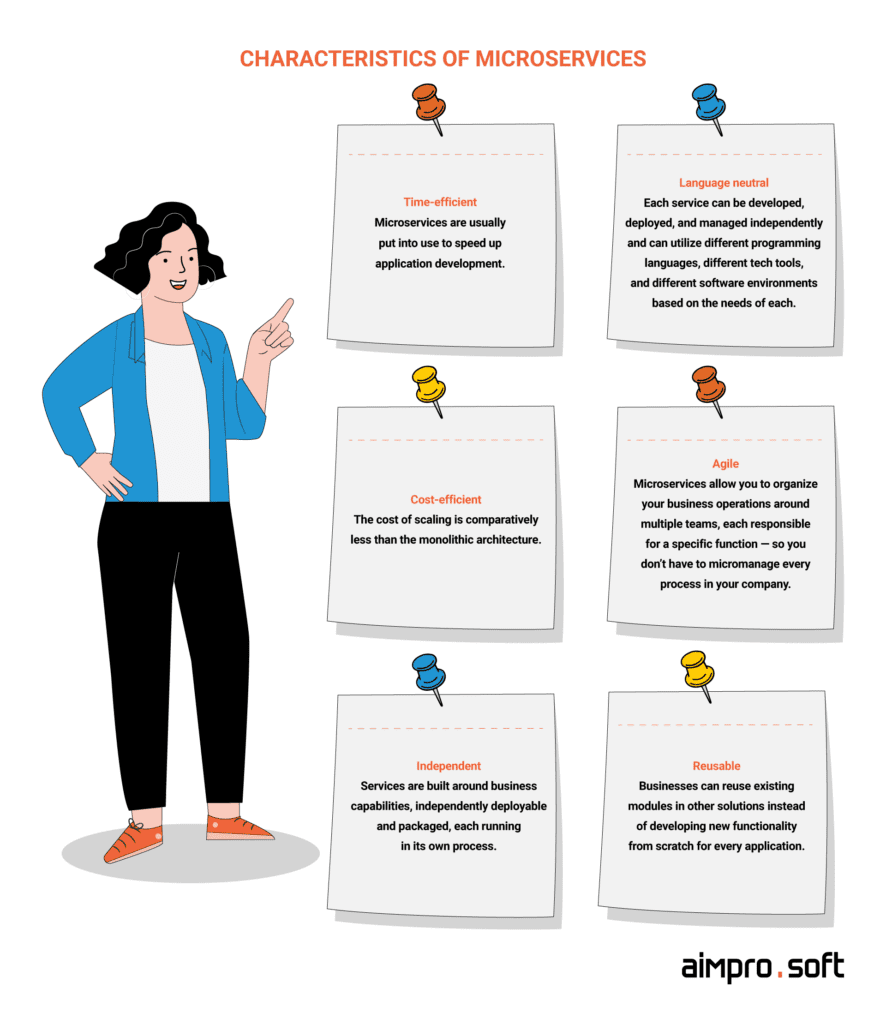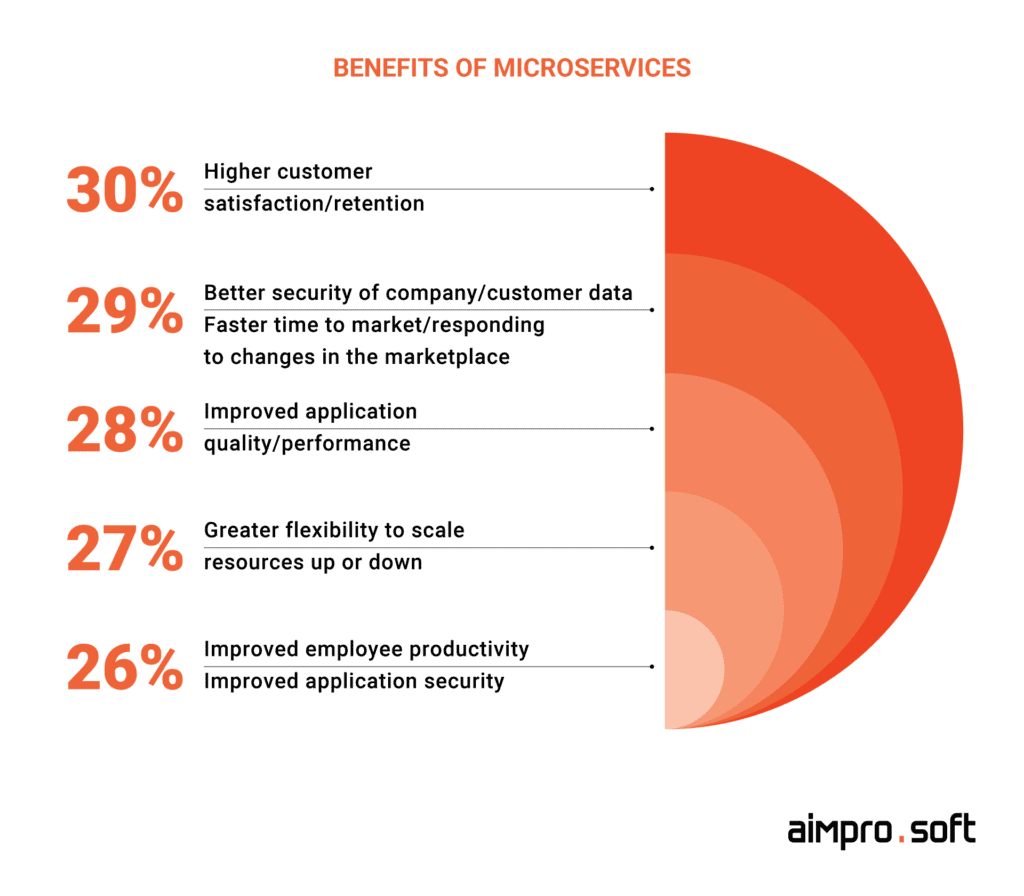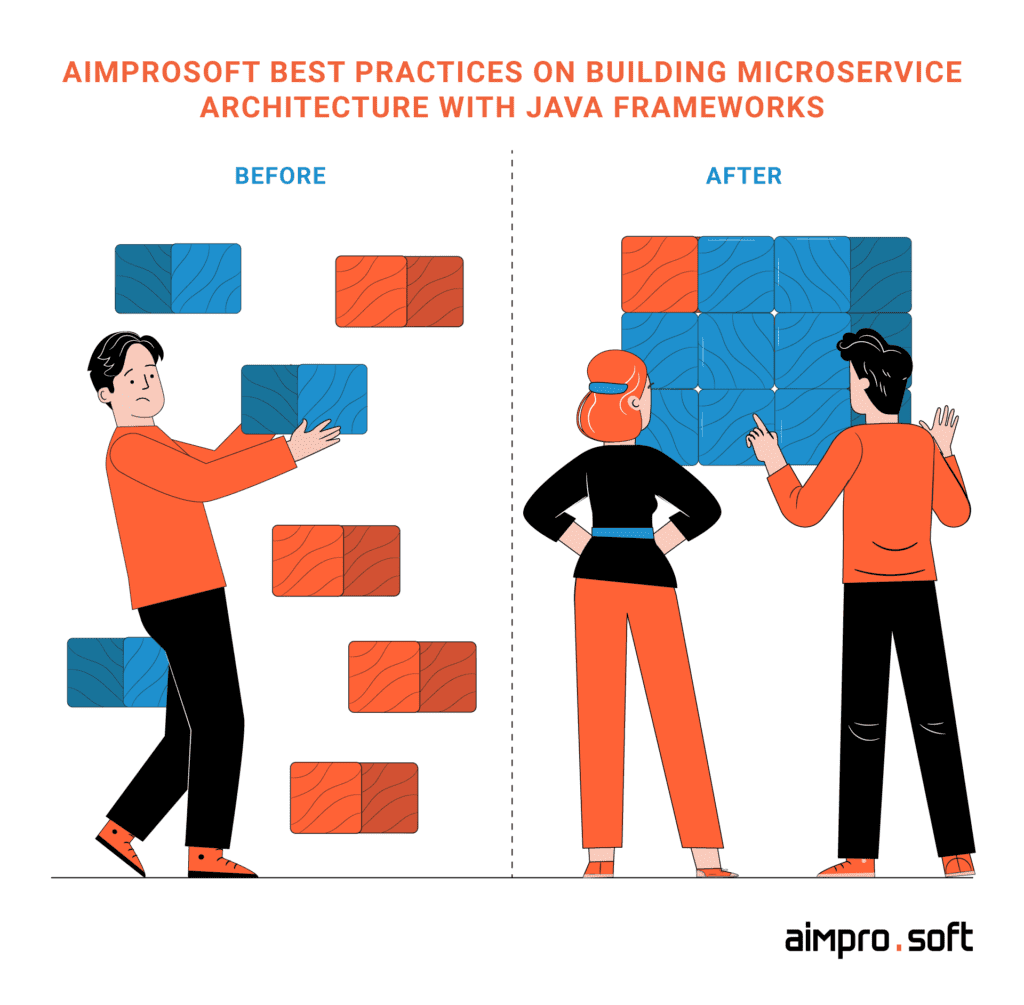3 Best Java Frameworks for Microservices in 2024

- Microservices: a friend or a foe? Check out what microservices architecture is and the reasons why businesses should adopt it.
- What is a popular Java framework for developing microservices? What if we say that there is more than one? Check out our Java microservices framework comparison, which includes one of the most popular tools on the market that are also praised by our developers for their efficiency. Learn their pros, cons, and nuances in terms of usage.
- Certain criteria should be considered when choosing a Java framework for your solution with microservice architecture. Explore our tips on how to select the right one, and scale instead of failing.
- Learn useful best practices that we apply during product development on how to work with popular Java microservice frameworks.
Microservice architecture is no longer some buzzword or fancy technology that should be adopted, well, only because it’s trending. It’s now a time-proven solution that is used by numerous companies when they need to build scalable, resilient, and future-proof solutions. According to the research, the cloud microservices market size was valued at $915.27 million in 2021 globally, and revenue is expected to grow at 20.71 % from 2022 to 2029, reaching nearly $4 billion. Amazon, Netflix, and Uber are only just a few bright examples of tech giants who have switched to microservices and managed to overcome major challenges to achieve their ultimate business goals.
However, even these industry leaders had a thorny path till they reached the desired objectives. Hence, a firm decision to use this architecture type is only a way to success; to make this goal achievable, it’s necessary to select the right tech stack and implement microservices using the right approaches. This article is aimed to help you deeper understand the value of microservices, figure out the cases when they are recommended and when not, obtain insights on what Java frameworks can be used to build them, and figure out how to design a microservice-based app and succeed.
Microservices: fantastic beasts and when businesses should adopt them
A microservice architecture (MSA) is an approach to designing software solutions that presupposes the creation of an application fragmented into small, loosely coupled modular components and services instead of building one big monolithic product. The created services are independently deployable, highly maintainable, barely depend on each other, and each runs a unique process. The main objective for building MSA is to gain the ability to add initially unplanned services to the solution easily and scale certain parts of the application in a simpler way without affecting the rest of the system. Check out the image below to get a general overview of the microservice architecture.

Microservice architecture
MSA is often chosen by companies over the traditional monolithic approach mainly due to its ability to shorten the development and deployment lifecycles while reducing the cost as a result. We’ll explore the benefits in more detail in the next section; meanwhile, let’s explore the main characteristics of microservice architecture in the image below.

Characteristics of microservices
However, despite all the benefits that this modern approach to building software applications can bring to your business, it’s not a silver bullet that should be applied in any business scenario. Based on our experience, we gathered cases when building modular, easily testable microservice architecture is highly efficient, and those scenarios when it can be more of a burden rather than an efficient solution.
Cases when the usage of microservice architecture is recommended
As we already mentioned above, MSA is not everyone’s cup of tea. The main reason why not every business needs to build microservice architecture is that its time and cost-consuming and requires specialists with profound knowledge and vast skillset, and needs certain organizational changes to adapt to microservices correctly.
Two legendary microservices thought leaders: Sam Newman, author, speaker, and independent consultant specializing in cloud, continuous delivery, and microservices, and Martin Fowler, speaker, and author of dozens of books on software development, shared their knowledge on microservices adoption in the on GOTO conference in 2020. When asked when MSA should better be used, Newman said, “tech industry tends to focus on tech instead of the outcome. One should use microservices as a means to obtain the desired outcome rather than for the sake of using new technology.”
He also added that a microservice architecture is a conscious choice you have made to implement something in that style because of some outcome you’re looking for. “There is some benefit that you think a microservice architecture is going to give you. So my qualifying criteria is: What is the thing that a microservices architecture is going to give you?”
In turn, Fowler commented on the nuance of adopting microservices, saying, “Consistency is another reason to be very wary of going down the microservice path, right? Because it’s a whole more complicated world of eventual consistency that you’ve got to start dealing with, and you can no longer keep things all straight with each other.”
As you can see, microservices are something that should be approached with precise consideration. So, in order to understand whether it’s the right fit for you, let’s check out both cases when MSA is the right option and when not that we gathered based on our expertise gained over the years building microservice-based apps for our clients.
- When you aim to refactor and update large-scale legacy applications which need a robust and contemporary IT infrastructure;
- Apps with real-time data processing (such as Netflix and Twitter);
- When you want your monolithic software to gain scalability, agility, manageability, and delivery speed;
- If you’re building a highly agile application (product or service) that demands swift speed of delivery, innovation, and more (such as cases when you wonder how to make a website like Udemy or how to make a website like Pinterest that are representatives of modern products with great performance).
Cases when the usage of microservice architecture isn’t recommended
- Non-complex legacy applications which don’t have a future roadmap;
- Intranet-based admin systems which are not critical for business;
- No business value was added for all the time, effort, and money that was invested;
- The company cannot manage and maintain multiple dev teams working independently and simultaneously;
- Small-scale products which cannot handle integration and infrastructure spendings;
- Several dependencies and external integration points.
Contact us, and our specialists will help you with the evaluation of your business and assist with creating a microservice-based app.
CONTACT USWhat benefits do microservices offer?
Microservices architecture wouldn’t be so popular if it didn’t bring so many benefits for businesses. In 2021 IBM Market Development & Insights conducted a survey, during which more than 1,200 IT executives, developer executives, and software engineers from large and mid-sized companies that are currently using a microservices approach were interviewed, as well as non-users who are only planning to adopt MSA. According to the gathered insights, professionals state that they see improvements from microservices across many areas of their business. You can view them in the image below.

Benefits of microservices. Source: IBM
Based on the survey, we can see that there is wide acceptance among IT executives and software development professionals who currently use a microservices approach that it can provide significant, ongoing business benefits. Let’s view in detail all the major benefits that microservice can bring to your business.
Improved scalability
One of the key benefits the microservices offer is their ability to be scaled horizontally easily, which is crucial for applications where scalability is a top priority. Since the services are separated from each other, each has its dedicated resources. Hence, in case of an unpredictable system load caused by, for instance, increased user traffic, the entire system won’t be affected, unlike if it’s a monolithic application.
As a result, thanks to improved scalability, it’s possible to prevent outages and avoid a negative user experience. Additionally, scalability helps conduct updates and deploy new functionality without the need to take it down the system, enabling seamless functioning of the system while the changes occur.
One of the brightest examples, when the scalability challenges were overcome with the help of microservices, is Netflix. Back in 2008, Netflix experienced service failure caused by growing server demands. The company decided to refactor its monolithic structure into a microservice-based one running on AWS. The switch allowed the company to increase fault tolerance, improve scalability, and enable seamless business growth.
Accelerated time to market
The ability to help businesses speed up their deployment cycles is another benefit that microservices provide. Since development teams work on different microservices separately, companies can implement and deploy new functionality faster, as well as update older components. For instance, Uber decided to shift from a monolithic architecture to microservices since they faced multiple operational issues (i.e., risky deployments, poor scalability, slow functionality updating) as soon as the company started growing rapidly.
The implementation of MSA helped the startup accelerate their deployments, enable faster business growth, and ensure high performance and autonomy of the teams.
Better fault tolerance
When it comes to monolithic architecture, a failure of a certain element can affect the entire system. However, in the case of microservices, businesses can avoid cascading failures since if one component fails, the rest of the system will most likely remain intact because the services run independently. As a result, the identification of a root problem becomes faster, and the entire system doesn`t have to be redeployed to make changes and fix the issue, which eventually leads to a reduction in downtime.
Versatility of available tools to implement microservices
Thanks to the way the microservices are built, engineering teams that work on each service can assemble the technology stack that will work best for the particular component. Such a technology-agnostic approach provides businesses with greater flexibility and the ability to avoid vendor or technology lock-in.
The benefits mentioned above are not the only ones that microservices can offer. We explored those key ones that can bring companies productivity acceleration, cost reduction, and scalability. Now it’s time to explore one of the most popular programming languages that are used for building MSA, which is Java, and learn more about its frameworks and the way to select the best-fit ones for your project.
Building microservices with Java
It’s worth noting that when selecting a programming language when building MSA, it’s important to consider different factors to make the right choice, such as the number of users that will use your product, integration with third-party services, the leverage of third-party libraries, etc. As we already mentioned in the previous sections, thanks to the independent nature of microservices, it’s possible to use various technologies for their implementation. According to the research, Java is considered one of the most favorable programming languages among developers (41% of respondents chose Java) for building MSA.
It’s not surprising since one of the key benefits of Java programming language is its vast dev community, which reduces the problems of how to hire Java developers in a fast way. It also has numerous ready-made solutions and the ability to process large data streams and users steadily.
Thus, according to our senior Java developer Dmitriy, when it comes to the selection of ready-made tools for building Java microservices, there is everything software engineers may need to build the main types of services quickly and properly. Moreover, microservices built with Java can be easily integrated with cloud systems since most of the SDKs of popular cloud services are implemented with the help of this programming language.
Finally, quite an impressive Java microservices framework list is another key reason why this language is so popular when building MSA. These microservices frameworks in Java facilitate and speed up work. They frameworks make the setup and configuration process simpler, and they also aid developers in inter-microservice communication. So, let’s explore the top frameworks that can be used for building a Java microservices platform.
Each solution is unique and requires an in-depth assessment before building it. Find out how discovery phase can help you eliminate major risks before the start of the development.
Best Java frameworks for microservices
We already mentioned that the variety and efficiency of frameworks are the reason why Java is so popular in the dev community when it comes to building MSA. In this section, we offer to explore the aspects that should be considered before choosing the right framework and then check out the top frameworks for microservice-based Java software development, their advantages, disadvantages, and use cases.
How to choose a framework and win scalability and resilience for your project
So, before exploring top, in our opinion, Java frameworks for building MSA, let’s take a look at key criteria that should be considered before choosing such technology for your project so that you would know how to shortlist them yourself properly.
- Ease of development. The very essence of frameworks is to enhance developer productivity and optimize the project outcome. It’s important to choose those frameworks that are easy to use, rich in terms of available tools, have well-written technical documentation and can enable faster development.
- Maturity of the community. There are numerous developers who work with microservices. Before choosing the framework, check the community of the microservices framework, paying attention to its history, popularity, size, reputation, and consistency in terms of updates.
- Integration with cloud systems. It’s a must to check the availability of integration/deployment with the cloud system which you are going to use.
- Automation support. Check the framework for support for automation. It means that in order to save time, microservice deployment and implementation should be automated.
Spring Boot

Spring Boot framework for building microservices
Advantages: a large community of helpful users, cost-effective open source framework, well-secured features, accelerated development cycle, a large number of developers, which makes it easy to assemble the team of skilled specialists, ability to configure the product in a flexible way thanks to a robust, easily configured, and stable IOC.
Disadvantages: large deployment files, needs to rely on the Spring ecosystem instead of using other tools that many developers find advantageous. Compared to Micronaut, it has worse support of serverless functions, such as AWS Lamda, and requires a longer microservice setup.
Cases when it’s better to use it. It’s better to use this framework for those products that require gradual scaling and can encompass a large amount of functionality that is related to one particular model. It’s better to use it also if you need to migrate the app that is written with Spring. Also, keep in mind that it’s easier to assemble a team of developers that are skilled in this framework than any other, thanks to its popularity and maturity of the community. Finally, compared to Micronaut, Spring Boot works better with message brokers; namely, it helps set them up easier and has more supported services.
Micronaut

Micronaut framework for building microservices
Advantages: boosted developer productivity, rapid and easy testing, low memory consumption, a smooth learning curve for software engineers, enables accelerated start-up time, reduced memory footprint.
Disadvantages: since Micronaut is quite new and less mature than other Java frameworks, there are fewer available skilled specialists. Also, the narrow focus of the framework won’t allow you to change the service architecture if necessary. Hence, during product growth, it’s possible to face certain limitations, and all the benefits can be offset by overcoding.
Cases when it’s better to use it. Similar to Spring Boot, Micronaut should be used when you need to build a system properly divided into smaller components and in case you have a team with developers specializing in this framework.
Axon

Axon framework for building microservices
Advantages: ensures fast scaling, has vast dev community worldwide, can meet the most demanding business requirements. The framework enables extremely rapid completion of the request and response to the user actions.
Disadvantages: microservices built with Axon are hard to be covered with tests, it’s complicated to test bugs, and they require large memory capacity. It also requires hiring developers who can apply DDD (domain-driven design) patterns and understand their main concepts. Also, such microservices require more initial investments since more resources are required in the cloud to deploy the system.
Cases when it’s better to use it. The usage of this framework is justified when you have certain input parameters, such as the need for a rapid user interface, the relevance of data is less important than the speed of processing, and the amount of data received from users is relatively less than such data submission, and simple flows of request processing for the change.
As you can see, each of the explored frameworks has lots of nuances in terms of their nature and use cases. Hence, careful analysis of your project needs, requirements, initial resources, availability of specialists in the market, and many other factors should be considered when selecting the best Java framework for microservices.
Contact us, and our specialists will help you select the right one.
CONTACT USAimprosoft best practices on working with microservices using Java frameworks

Aimprosoft tips on building MSA with Java frameworks
Microservice deployment and development might be challenging as well as choosing the right framework for their building. To avoid typical mistakes and make the most of this design, it’s important to follow recommended practices for implementing and deploying microservices. Before checking out the list of tips that our senior Java developer recommends following, we offer to explore the list of questions that should be asked before deciding to build an MSA.
- Is your business mature enough to adopt MSA?
- Do you fully comprehend how microservices can impact your development processes?
- Does your microservice framework allow for the integration of CI/CD technologies to enable DevOps? Does it support continuous integration, deployment, and continuous delivery (CI/CD)?
- Does your framework support automation technologies for faster and more efficient development?
- What is the planned scale of the project? What is your vision of scaling up?
Once you have clear answers to the mentioned questions, it will be easier for you to get started with MSA properly. Also, don’t forget to examine the best practices that we’ve prepared based on our experience.
- It’s necessary to think through the system’s architecture before you start building microservices.
- In the early stages, it’s a must to plan the process of microservice configuration and deployment in every type of environment.
- It’s necessary to address logging responsibly for further debugging.
- We recommend carefully approaching distributed transactions and asynchronous processing of events.
- Since each microservice is developed independently, we recommend creating a set of standards that will allow you to avoid inconsistency across your system, problems for new team members to get started working on your project, and challenges of maintaining the product over time. It may include creating communication protocols, directory structures, etc.
- Due to the fact that microservices are self-contained, meaning each of them has its database, codebase, tech stack used for their implementation, and many other components, it may be challenging to manage them if their amount grows over time. To avoid this obstacle, it’s vital to have a well-thought-out strategy for managing your MSA that will determine boundaries between all services.
Reach us, and we’ll examine your requirements to help you find the right approach to your product development.
CONTACT USConclusion
As you can see, the microservice architecture gives businesses the ability to build complex solutions, allowing obtain scalability and the necessary flexibility. Java and its frameworks are the right solutions if you want to benefit from this architectural approach. Use the best practices that we provided in the article to achieve your goals, or contact Aimprosoft right away to get a guaranteed result with the help of our expertise and skillset. Choosing a trusted software vendor to build a microservice-based solution is a win-win strategy for businesses that want to embrace the advantages of digital transformation to a full extent.
Which Java framework is best for microservices?
Microservices are not a well-established architecture; still it’s constantly evolving. It means that there is no one one-size-fits-all tool that can be the answer to what is a popular java framework to develop microservices. It’s better to choose a framework by the team’s expertise. If there are several frameworks that your specialists are skilled in, create Java application architecture and choose the most suitable one based on implemented libraries/functionality/ease of development of products for your domain. In this way, less time will be spent on building certain key features with the same quality of their implementation. Also, you should take care that the chosen framework scales well on the cloud service you use (and you will have to scale it sooner or later).
Which Java version is most scalable for microservices?
Nothing really depends on the version of Java. Newer versions add new tools which developers can use. Also, versions newer than 9.0 can help reduce the bundle application, which can reduce resource consumption.
What are the frameworks to fit the best huge projects?
In our practice, Spring is the best because we (and probably all companies) have the greatest expertise working with this technology. Also, there are already a lot of solved problems that may arise during the development/support of the application. All the rest need to be tried for each project because the choice of another framework can, in some cases, reduce the development process and, as a result, save money.




